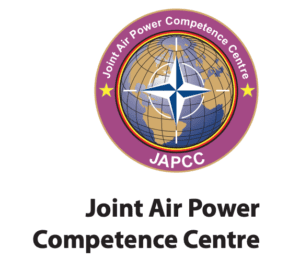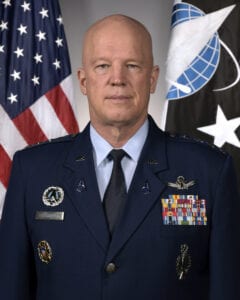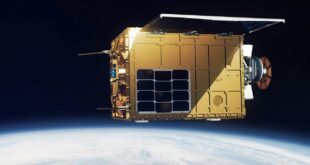 As part of the partnership between SpaceWatch.Global and Joint Air Power Competence Centre, we have been granted permission to publish selected articles and texts. We are pleased to present “NATO Space” by Gen John W. Raymond, originally published on the Joint Air Power Competence Centre website.
As part of the partnership between SpaceWatch.Global and Joint Air Power Competence Centre, we have been granted permission to publish selected articles and texts. We are pleased to present “NATO Space” by Gen John W. Raymond, originally published on the Joint Air Power Competence Centre website.
By Gen John W. Raymond, Chief of Space Operations, US Space Force

International cooperation in Space has never been more important than it is today. Chinese and Russian military Space activities present serious and growing threats to NATO’s security interests due to their development, testing, and destabilizing deployment of counterspace capabilities, along with their associated military doctrine for employment in conflict extending into Space. Although the broader strategic threats posed by China and Russia are different, each has weaponized Space as a means to challenge our freedom of operation in Space and reduce US and NATO military effectiveness. NATO’s Space strategy and doctrine should be poised to counter, respond to, and deter the full range of competition and military conflict, including hybrid threats and military activities that fall short of war.
In recognition of this security environment, the United States has reemphasized the importance of international engagement, and the US Space Force is seeking to create greater opportunities for cooperation across NATO member states and spacefaring partners. The United States is committed to working alongside Allies to deter and defend against aggression from hostile adversaries.1 In March 2021, the White House released the Interim National Security Guidance, and the continued importance of Space and international cooperation is explicitly highlighted:
We will explore and use Outer Space to the benefit of humanity, and ensure the safety, stability, and security of outer Space activities. We will shape emerging technology standards to boost our security, economic competitiveness, and values. And, across these initiatives, we will partner with democratic friends and allies to amplify our collective competitive advantages.2
NATO member states understand that Space is an integral component of their respective national soft and hard power security strategies. By recognizing Space as an operational domain and establishing a new NATO Space Centre at Ramstein, Germany, NATO leaders have acknowledged the increasing counterspace threats posed by potential adversaries.3 To achieve the security objectives of the Alliance – while ensuring freedom of action in Space – member states and key partners need to lead in the promotion and demonstration of norms of responsible behaviour in Space; promote technological innovation and acquisition agility; mature a transparent attribution process; and develop Space professionals.
Lead in the Promotion and Demonstration of Norms of Responsible Behaviour
The need to define non-binding norms of responsible behaviour for Space operations has considerable international support. Within the United States, policy and strategy documents have highlighted this need as well, to include the most recent National Space Policy that notes the need to promote ‘norms of behaviour for responsible national security activities that protect United States, allied, and partner interests in Space’.4 Also, the US Defense Space Strategy underscores the need to ‘join with allies, partners, and other US Government departments and agencies to promote favourable standards and norms of behaviour in Space.’5 In the second year of the new US Space Force, we are focused on enhancing integration with existing alliances and partnerships, including working toward mutually beneficial tenets for responsible behaviour in Space.
NATO provides a forum to discuss the development of international norms of responsible behaviour for the utilization of Space that consider the changing Space landscape and security implications. This is especially true given the expected growth in Space traffic management, on-orbit servicing assembly and manufacturing, and rendezvous and proximity operations. Collaboratively, the Allies should take actions that enhance Space domain stability and reduce the potential for miscalculations. NATO can promote norms of responsible behaviour in Space favourable to Alliance and key partners’ interests. This collaboration could contribute to enhancing the safety and stability of the Space environment to facilitate peaceful exploration, science, and commercial activities.
Promote Technological Innovation and Acquisition Agility
China and Russia continue to develop Space capabilities that reduce the technological advantage long enjoyed by NATO Allies. Failure to innovate, adapt, and become more agile may make the Alliance’s Space capabilities less relevant in the near future. In the worst case, disadvantage in Space can create vulnerabilities for Allied forces in multiple domains.
Space Force establishment allowed creation of new organizations and processes to unify complementing Space functions and authorities, already resulting in enhanced security options. To promote greater efficiencies, NATO members could likewise coordinate activities such as cooperative Science & Technology and Research & Development efforts. Working in a coordinated manner, NATO can help ensure our Space capabilities and associate architectures are fully functional throughout the spectrum of peace, deterrence, and conflict.
Prudent risk-taking is inseparable from the concepts of innovation and agility. Military Space forces must be skilled at managing risk, always seeking mission accomplishment at the speed of relevance while recognizing that perfection is often the enemy of good-enough. Protracted acquisition processes can lengthen decision cycles and dilute the transformative potential of proposed innovations. Leaders must continually seek the proper balance between desired capabilities and fielding schedules, between rigour and efficiency, and between deliberation and action.6 A significant element of Space Force’s organizational transformation is creating both the organizational structures and a Service culture that help leaders at all levels balance these complex concerns while addressing an overall imperative for timely action.
Furthermore, to ensure that NATO has the requisite capabilities to be relevant in the future, it is critical to incorporate the innovation experience of the commercial Space sector. The commercial sector – whether satellite operators, launch service providers, or the manufacturing supply base – should play a significant role in NATO’s operations and strategy. Commercial Space activities have expanded significantly in both volume and diversity, resulting in new forms of commercial capabilities and services that leverage commoditized, off-the-shelf technologies, and lower barriers for market entry. Together with civil Space agencies with whom we share a common industrial base, the Alliance can leverage innovation and cost-effective investments driven by the private sector, presenting opportunities to develop novel capabilities with a more streamlined and responsive acquisition process. By incorporating the innovation experience of the commercial sector, NATO can implement more effective operations and deterrence strategies, especially as potential adversaries seek to outpace our technological advantage and Space-based capabilities.
Mature a Transparent Attribution Process
A credible, trusted, and transparent Space attribution process – the ability to trace the origin of an action against Space architectures – underpins a successful NATO Space deterrence strategy. Inability to determine the origin or source of a hostile or malicious action undermines the expectation of a credible response.7 Space Domain Awareness (SDA) is a critical part of attributing threatening or malicious action against Space architectures. SDA encompasses the effective identification, characterization, and understanding of any factor associated with the Space domain that could affect Space operations.8 The United States has already crafted more than 100 agreements to share situational awareness to support safe satellite operations.
SDA alone, however, may not be enough to enable Space attribution. We must go deeper in our understanding of the domain. We must develop the means to determine the source and pathway of an attack against Space architectures after such an attack has occurred.9 We need scientific methods to gather data and information from satellites, ground systems, and associated networks regarding actions that are non-kinetic or kinetic, and reversible or non-reversible. For hostile actions in Space, the attribution process may lead to a military response. Yet for less serious acts in Space, attribution may lead to prosecution through civilian courts or diplomatic admonishment.
For the Space attribution process to be viable when needed, NATO Nations must prepare now to develop the requisite SDA and scientific capabilities, rehearse related intelligence collection and information sharing, and integrate trusted commercial partners. By rehearsing the attribution process – such as during combined Space exercises and wargames – it may be determined that additional SDA capabilities are needed. Working together and sharing intelligence and information will lead to increased transparency and build trust and confidence in the Alliance’s Space attribution process. This trust and confidence established in peacetime can result in additional countries joining the Alliance’s effort during times of crisis.
Develop Space Professionals
The impressive technology that enables spaceflight can sometimes obscure the most important component of Spacepower: our people. Indeed, across NATO’s Space community, our greatest assets are the men and women – the Space professionals – who develop, employ, and advance Spacepower. Sound doctrine and superior capabilities are of little use without personnel who have the expertise and empowerment required to wield them. It is of utmost importance that NATO prioritize the development of its Space professionals, ensuring that the Allies’ militaries have the leadership, professional expertise, and foresight necessary to protect and defend the Alliance’s interests in any future environment, including the Space domain.
Developing Space professionals requires a deliberate process that cultivates a common knowledge base, incorporates professional experience across disparate mission areas, and allows a range of opportunities for leadership advancement.10 The US Space Force is promoting a number of targeted development efforts to ensure Guardians, as well as Allies and partners, develop and maintain a global perspective to provide innovative solutions that are effective and relevant to both national and Alliance security interests. Efforts to develop our professionals, like efforts to develop technology, benefit from cooperation. NATO Space professionals need to be knowledgeable and agile in leveraging the capabilities of the other military services, Allies, and the commercial sector.
Looking Up and Forward
When it comes to protecting common interests in Space, the NATO Alliance is greater than the sum of its individual member countries. The United States recognizes this and is moving to reenergize its arrangement of alliances and partnerships built on trust, democratic values, and shared national interests to address emerging Space-related matters. The US Space Force will do its part in strengthening and standing with our Allies, working with like-minded partners, and pooling our collective strength to advance shared interests and deter common threats. The US Space Force is committed to ensuring Space remains accessible, secure, and stable – for the benefit of not only Americans, but the entire world.
Space has a critical role in international security because all the world’s major powers are also Space powers that seek to broaden their use of Space. Given the lessons of history, the strategic advantage derived from Space-based capabilities will not remain unchallenged. The Alliance is well positioned to ensure the needed collective responses to our biggest challenges. NATO can and should play an important role in ensuring peace and stability within the Space domain.
Endnotes
1. The White House, ‘Interim National Security Guidance’, Mar. 2021, p. 19.
2. Ibid., p. 17–18.
3. NATO, ‘NATO’s approach to space’, 23 Oct. 2020, https://www.nato.int/cps/en/natohq/topics_175419.htm.
4. The White House, ‘National Space Policy’, 9 Dec. 2020, p. 29.
5. US Department of Defense, ‘The Defense Space Strategy: Summary’, Jun. 2020, p. 8.
6. Headquarters US Space Force, ‘Space Capstone Publication, Spacepower’, Jun. 2020, p. 58.
7. Gleason M. and Hays P., ‘Getting the Most Deterrent Value from U.S. Space Forces’, Center for Space Policy and Strategy (2020), p. 3.
8. Ibid. 6., p. 34.
9. Klein J. J., ‘Understanding Space Strategy: The Art of War in Space’, Abingdon: Routledge, 2019, p. 82.
10. Ibid. 6., p. 47.

General John W. ‘Jay’ Raymond is the Chief of Space Operations, United States Space Force. As Chief, he serves as the senior uniformed Space Force officer responsible for the organization, training and equipping of all organic and assigned Space forces serving in the United States and overseas.
Rights reserved – this publication is reproduced with permission. The original was published on https://www.japcc.org/nato-space-2/





